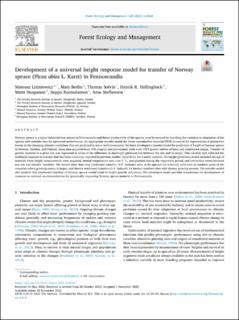| dc.contributor.author | Liziniewicz, Mateusz | |
| dc.contributor.author | Berlin, Mats | |
| dc.contributor.author | Solvin, Thomas Mørtvedt | |
| dc.contributor.author | Hallingbäck, Henrik R. | |
| dc.contributor.author | Haapanen, Matti | |
| dc.contributor.author | Ruotsalainen, Seppo | |
| dc.contributor.author | Steffenrem, Arne | |
| dc.date.accessioned | 2023-01-11T09:34:36Z | |
| dc.date.available | 2023-01-11T09:34:36Z | |
| dc.date.created | 2022-11-28T08:48:48Z | |
| dc.date.issued | 2022-11-18 | |
| dc.identifier.citation | Forest Ecology and Management. 2022, 528 . | en_US |
| dc.identifier.issn | 0378-1127 | |
| dc.identifier.uri | https://hdl.handle.net/11250/3042604 | |
| dc.description.abstract | Norway spruce is a major industrial tree species in Fennoscandia and future productivity of the species must be secured by matching the variation in adaptation of the species with suitable sites for optimized performance. An appropriate transfer model for forest reproductive material (FRM) is crucial for regeneration of productive forests in the changing climatic conditions that are predicted to occur in Fennoscandia. We have developed a transfer model for prediction of height of Norway spruce in Norway, Sweden, and Finland, using data acquired from 438 progeny and provenance trials with 1919 genetic entries of local and transferred origins. Transfer of genetic material at a given site was expressed in terms of the difference in daylength (photoperiod) between the site and its origin. This variable best reflected the nonlinear response to transfer that has been commonly reported in previous studies. Apart from the transfer variable, the height prediction model included the age of material when height measurements were acquired, annual temperature sum over 5 °C, precipitation during the vegetation period, and interaction terms between test site and transfer variables. The results show that long northward transfers (4-5° latitude) seem to be optimal for relatively mild sites in southern parts of the countries where growing season is longer, and shorter northward transfers (2-4° latitude) for harsher northern sites with shorter growing seasons. The transfer model also predicts that southward transfers of Norway spruce would result in height growth reductions. The developed model provides foundations for development of common or national recommendations for genetically improving Norway spruce material in Fennoscandia. | en_US |
| dc.language.iso | eng | en_US |
| dc.publisher | Elsevier B.V. | en_US |
| dc.rights | Navngivelse-Ikkekommersiell 4.0 Internasjonal | * |
| dc.rights.uri | http://creativecommons.org/licenses/by-nc/4.0/deed.no | * |
| dc.title | Development of a universal height response model for transfer of Norway spruce (Picea abies L. Karst) in Fennoscandia | en_US |
| dc.title.alternative | Development of a universal height response model for transfer of Norway spruce (Picea abies L. Karst) in Fennoscandia | en_US |
| dc.type | Peer reviewed | en_US |
| dc.type | Journal article | en_US |
| dc.description.version | publishedVersion | en_US |
| dc.rights.holder | © 2022 The Authors | en_US |
| dc.source.pagenumber | 11 | en_US |
| dc.source.volume | 528 | en_US |
| dc.source.journal | Forest Ecology and Management | en_US |
| dc.identifier.doi | 10.1016/j.foreco.2022.120628 | |
| dc.identifier.cristin | 2082038 | |
| dc.relation.project | EC/H2020/773383 | en_US |
| dc.source.articlenumber | 120628 | en_US |
| cristin.ispublished | true | |
| cristin.fulltext | original | |
| cristin.qualitycode | 2 | |

